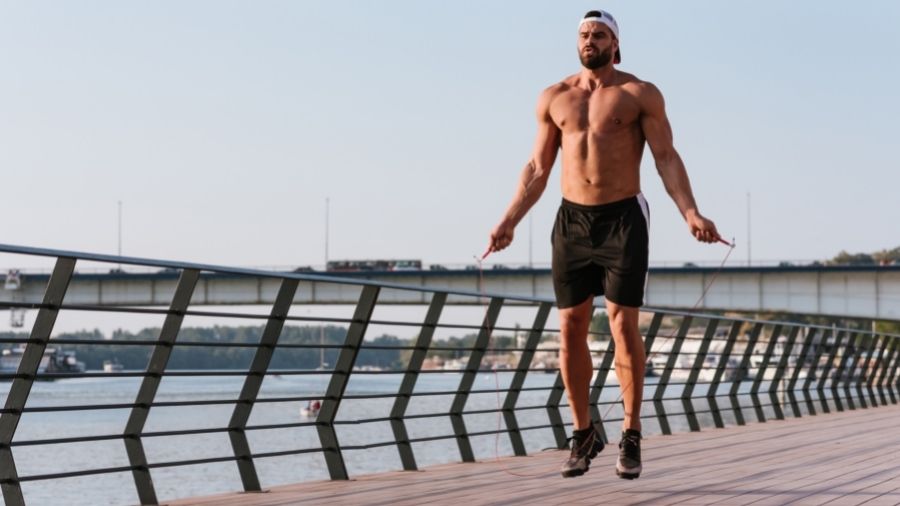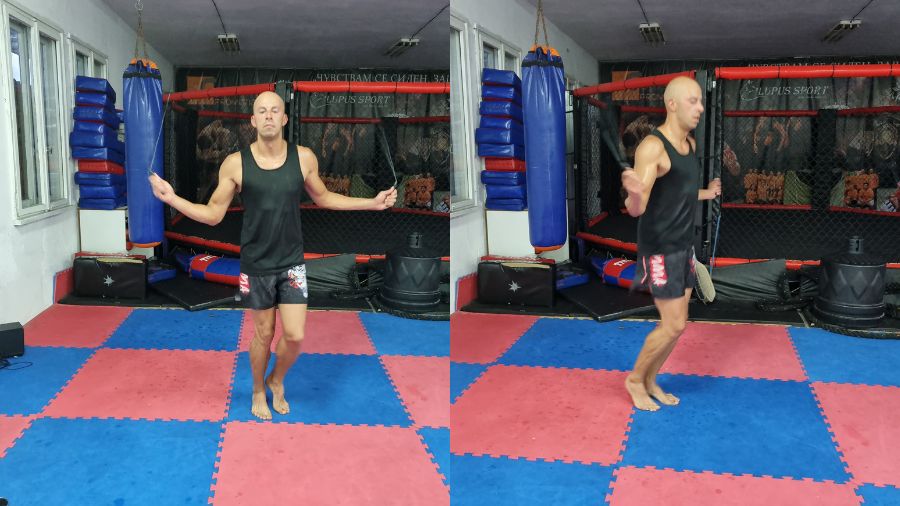Jumping rope is a staple in martial arts—even newer martial arts like MMA. But MMA isn’t boxing who live and die by the jump rope. So, why do MMA fighters jump rope?
MMA fighters jump rope to improve their footwork and develop aerobic endurance and explosiveness. Jumping rope is a low-level plyometric activity that you can perform for long durations and high frequencies.
But do you really need to jump rope to be a great MMA fighter?
Do MMA Fighters Need To Jump Rope?
Need is a strong word to use. Do you need to hit the heavy bag to be a good MMA fighter? Or speedball? Probably not, but they are great tools to develop particular areas of your MMA.
The same goes with jumping rope. Could you become a great MMA fighter without skipping? Sure. But jumping rope is an excellent tool for MMA fighters and has been around for decades to prepare MMA fighters for competition.
Just check out Dustin Poirier jumping rope as part of his warm-ups.
What Are The Benefits Of Jumping Rope?
There’s a reason jumping rope has stood the test of time. It’s an effective training tool that derives multiple benefits specifically for MMA. Here’s a list!
Footwork
We all know the importance of footwork to MMA. From staying light on the feet to evading punches and takedowns to delivering your own punches, counter punches, and takedowns through various angles.

How to Dominate Every Fight with Raw, Explosive Power No One Can Match
Discover the underground blueprint that has quietly turned MMA hopefuls into legends, using nothing but sheer, brute force and bulletproof conditioning techniques.
Depending on the session’s goal, MMA fighters will vary how they skip to increase or decrease the intensity.
Rhythm Between Hands And Feet
Rhythm is the basis of every sport. Rhythm in MMA is often seen as the one who seamlessly evades punches and takedowns and can land their own in an almost God mode type state. It seems like they can see everything in slow motion.
This is a product of great agility, footwork, and technique. Jumping rope is one tool to help develop rhythm between the hands and the feet outside of technical MMA training.
Bulletproof Your Ankles
Compliant “loose” ankles are at a higher risk of injury. That is where you see people who can’t put the brakes on fast enough before rolling their ankles. Jumping rope enhances active stiffness of the ankle. Not to be confused with tightness or lack of mobility.
Active stiffness is the ability to redirect force rapidly. For example, when jumping rope. The ankle has to quickly hit the ground and return to the air as fast as possible. This stiffness can reduce the risk of rolling your ankle.
Punch Harder
Hard punches come from significant contributions from the legs. That means strong and stiff legs can transfer more force from the ground to the hands more efficiently.
Bounce And Quickness

Reactive strength is probably the most apparent benefit of jumping rope to the naked eye. Jumping rope is a plyometric action meaning a rapid eccentric, then concentric occurs with every bounce of the foot.
This improves the elastic ability of the spring-like tendon and the ability of the legs to use this elastic energy which translates into faster movements around the ring when bouncing.
Jumping rope is a very low intensity plyometric, so it can be performed frequently with little to no fatigue making it a perfect supplemental exercise for MMA.
While not specifically in MMA fighters, a 2020 study investigated jump rope training in endurance runners [1]. After 10 weeks of jumping rope as a 5-minute warm-up 2-4x a week, runners increased arch stiffness by 8%, drop jump height by 6%, and reactive strength by 13%.
If you don’t perform other reactive strength training outside of MMA, you can likely derive similar benefits from jumping rope.
Explosiveness
The same study also looked at explosiveness through jumping. These runners improved their vertical jump by 10.5% and their jump from a static position by 6%. Improvements in lower body power are likely to transfer to punching power.
Endurance (Aerobic Conditioning)
These improvements in reactive strength also led to a 3% improvement in 3 km run time. Which meant the improvements in “bounciness” made the runners more efficient when running, known as running economy.
Running economy is affected by many variables. But improvements in reactive strength can reduce the necessary contributions from the muscle when performing cyclical, plyometric tasks like running or bouncing around the ring.
Further, performing skipping within a technical MMA circuit or on its own for long durations with heart rates between 130-150 BPM develops your aerobic base that underpins your MMA performance.
Do MMA Fighters Jump Rope Every Day?
While MMA fighters will jump rope very often, they won’t jump rope every single day. There is no need to jump rope every day as there are other training modalities you need to fit in your training week, and at some point, you need to rest your body.
Jumping rope is a low-impact activity. However, there is still an impact from bouncing on and off the ground. So, for the overall health of your feet and legs, don’t jump rope every day.
Is Jumping Rope Better Than Running?

In my opinion, jumping rope is a better option than running as a conditioning tool for MMA. While both running and jumping rope are forms of exercise somewhat far removed from MMA movements, the adaptations from skipping are more beneficial to MMA than those seen from running.
As we know, roadwork doesn’t match the biodynamic structure of MMA, meaning MMA and running are two distinctly different activities. On the other hand, skipping can be performed to develop reactive strength easily transferable to MMA.
Further, it develops the reactive and explosive qualities needed to be a successful MMA fighter.
How Long Do MMA Fighters Jump Rope?
If MMA fighters jump rope as part of their warm-up, they may skip for 10-15 minutes. If jumping rope is being used to develop aerobic conditioning after an MMA session or as a standalone session, an MMA fighter may jump rope for 30+ minutes interspersed with various MMA drills such as shadowboxing or shadow wrestling.
Should You Jump Rope For MMA?
Jumping rope is not a training prerequisite for MMA. However, it is an excellent tool for developing explosiveness through the ankle. Whether you jump rope is down to personal preference. If you enjoy the activity, use it. If you don’t like jumping rope, there are many alternatives, such as extensive plyometric circuits, which you can see in my video below.
MMA Skipping For Beginners
If you are brand new to jumping rope, simply learning the rhythm and technique of double-legged jumps is where you can start. Once you start feeling comfortable, you can add more advanced jump rope techniques. Check out the video below to learn how to jump rope with a great example of a jump rope warm-up.
This video gives an excellent rundown of a skipping progression. Due to the low amplitude of the jumps or skips, the impact is low, and the mechanical load on the body is minimal. This means you can perform long durations at high frequencies of this style of jumping rope.
What Is The Best Jump Rope For MMA Fighters?
It’s always good to invest in decent equipment that will last you a long time and provide the best experience when training with it. I have bought crappy plastic jump ropes from the department store that would get tangled while skipping. It was a pain, and I would not recommend going down that route.
Instead, your best option for a jump rope is a speed rope. They work smoothly and are higher quality. It’s a game-changer. I recommend the BOXRAW Sokudo Jump Rope.
You can see our full BOXRAW Sokudo Jump Rope review here.

Jump ropes are cheap pieces of equipment, so it is worth buying something good that will last and not cause you problems during training. If a jump rope causes you issues, you may not use it as often as you’d like.
References
1. García-Pinillos, F., Lago-Fuentes, C., Latorre-Román, P. A., Pantoja-Vallejo, A., & Ramirez-Campillo, R. (2020). Jump-Rope Training: Improved 3-km Time-Trial Performance in Endurance Runners via Enhanced Lower-Limb Reactivity and Foot-Arch Stiffness. International Journal of Sports Physiology and Performance, 1(aop), 1-7.

